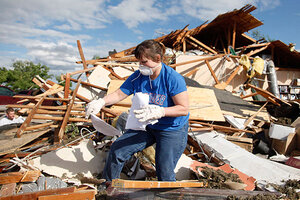Tornado warnings saved lives, but sirens aren't enough
Tornado sirens aren't designed to awaken residents and aren't fail-proof, as Woodward, Okla. learned. What tornado warnings were effective this past weekend.

Trish Ford, of Woodward, Okla., looks for personal papers for a friend whose office was destroyed by a tornado April 15, 2012. Clean-up efforts were underway across the Midwest after dozens of tornadoes tore through the region, killing six people in Oklahoma.
REUTERS/Jeff Tuttle
Woodward, Okla.
When a tornado shrouded in darkness and wrapped in rain dropped quickly from the sky above this northwest Oklahoma town, many residents relied on television weathermen to warn them of impending devastation. Others learned of the monster twister from neighbors or calls from frantic relatives.
One backup they couldn't count on was the town's 20 outdoor tornado sirens, which were knocked out when lightning struck a tower used to activate the warning system.
The storms, which caused multiple outbreaks of severe weather most of Sunday from Kansas to Minnesota, were part of an exceptionally strong system tracked by the National Weather Service's Storm Prediction Center in Norman, Okla., which specializes in tornado forecasting. The center took the unusual step of warning people more than 24 hours in advance of a possible "high-end, life-threatening event."
IN PICTURES: Extreme Weather 2012
In the end, only the Woodward tornado proved fatal. While it's unknown whether the disabled sirens contributed to the toll in Woodward, residents and officials in hard-hit areas of Kansas, Iowa and elsewhere credited days of urgent warnings from forecasters for saving lives.
"We can't do this with every event," said the prediction center's Ken Miller, noting that many storm systems are not as easy to predict whether they will be a potential threat to life and property.
Miller said he was pleased the warnings were heeded.
"We measure our success by how the public reacts," he said. "Do they take precautions seriously and act on them?"
In south central Kansas, Sedgwick County Emergency Management Director Randy Duncan credited the dire language warnings for saving lives.
"People become used to those warnings. That is a dangerous complacency," Duncan said. "We need to break through the clutter of everyday noise to get people's attention."
The warnings had Larry Hill's attention. The 72-year-old sifted Sunday through glass and debris of his home. Hours earlier, Hill had barricaded himself in a closet as a tornado ripped the roof off his home in the southwest Iowa town of Thurman. He kept a close ear on their television as Saturday night approached, and had bought extra groceries the night before.
"We'd been on the lookout for it for three days," he said. "... We were as ready as we could have been."
A National Weather Service official said a "month's worth" of tornados were spotted Sunday in Kansas. About 100 homes were damaged in a Wichita mobile home, but no serious injuries or fatalities were reported.
"We knew well ahead of time that this was going to be ugly. People listened" to the warnings, Sedgwick County Commissioner Tim Norton said.
The Woodward tornado hit after midnight and without warning from the town's knocked out siren system.
The state medical examiner's office identified the victims as Frank Hobbie and his 5-year-old and 7-year-old daughters, who died when the tornado hit the mobile home park, and Darren Juul and a 10-year-old girl who died when the home they were in a few miles away was hit. Office spokeswoman Amy Elliot said no other details were available but said a critically hurt child was airlifted to a Texas hospital.
Oklahoma Department of Emergency Management spokeswoman Keli Cain said early Monday that a sixth person had died following the Woodward tornado, although she could not immediately provide details of the victim's age or gender, nor of the circumstances of the death.
"Our thoughts and prayers just go out to the families that have lost their loved ones, especially the children," said Oklahoma Gov. Mary Fallin, who declared a state of emergency Sunday after touring the damage. "It's always devastating to hear about the loss of life of children."
Many residents in tornado alley have grown up counting on tornado sirens to warn them when a twister has been spotted on the ground, but emergency officials say that can be one of the least reliable methods, especially when a tornado hits at night.
"An outdoor warning system should never be the only way or even the primary way to receive a warning," said Rick Smith, a warning coordination meteorologist with the National Weather Service. "Our message that we preach is you have to have several ways to receive a warning."
Curt and Andra Raymer had taken steps to prepare for the storm, but thought they were in the clear when a television meteorologist warned residents to take cover just minutes before the storm hit.
"We heard the sirens yesterday afternoon, and they blew for 40 minutes," said Andra Raymer, 44, as she picked through the rubble of her home that was covered with insulation, broken glass and splintered wood. "Last night when this one came through, we didn't hear anything."
The couple and their dogs took shelter in an interior bathroom as the roof was lifted from their home and smashed in their backyard.
"We're just lucky to be alive," Curt Raymer said. "We walked out into the street and just couldn't believe it."
Emergency management officials urged residents to take advantage of weather radios, smartphones and television warnings to keep them up to speed when weather turns dangerous. Sirens are not designed to wake residents who are sleeping or to penetrate the thick insulation in today's homes, said Albert Ashwood, the director of Oklahoma's Office of Emergency Management.
"Sirens are referred to as outdoor warning systems, and that's what they're there for: to tell people who are outdoors to come inside and find out what's going on," Ashwood said.
___
Associated Press writer Roxanna Hegeman in Wichita, Kan., contributed to this report.

